Bibimbap (“bee-beem-bawp”) is a Korean dish that is almost as fun to say as it is to eat and translates to “mixed rice.” In celebrating California Avocado’s versatility, bibimbap is the quintessential rice bowl—a bowl of warm rice topped with an assortment of different cooked, raw and pickled vegetables and proteins and a sweet and savory sauce. Sometimes it’s topped with a fried egg and in one variation, everything goes into a dolsot, which is a stone bowl that is preheated to be sizzling hot before everything is added. Everything is put into the bowl and then a raw egg is cracked on top and then everything is quickly stirred together so that the egg cooks. Whichever version you eat, everything is stirred together right before you eat it.
I remember the first time I had bibimbap. My husband and I were on a Korean Air flight from Tokyo to Bangkok and bibimbap was one of the meal options. I remember how surprisingly delicious it was (I mean, c’mon, we’re talking airplane food!). On our return flight to Tokyo we had a long layover in the Seoul, Korea airport. I made sure that we had bibimbap in one of the restaurants because I had to eat it again! It is still one of my favorite Korean dishes.
Making bibimbap at home is one my favorite ways to cook with seasonal produce (hint: California Avocados). It’s also a great way to use up odds and ends from previous meals. Do you have leftover roasted potato wedges? Use them as a topping! Do you have leftover steamed broccoli? Toss it in a few drops of sesame oil and use it as a topping! I’m sharing my summer version of bibimbap with you, but use this as a general blueprint for making your own bibimbap. I kept things pretty simple, showing several different ways to prepare vegetables (sauté and quick pickle) as well as some items that don’t really need any preparation, like kimchi and California Avocado.



Avocado is definitely not a traditional ingredient, but bibimbap is all about contrasting flavors, colors and textures and California Avocado couldn’t be a better fit! Its creamy sweetness is delicious alongside the crunch of a quick-pickled carrot or the spiciness of a good kimchi.
Use this recipe as a jumping off point—use the same ingredients or substitute what you love or already have on hand. Add additional items as well, like grilled steak or pan-fried tofu. And by all means, top it with a fried egg if that’s your jam!


Summer Bibimbap Recipe with California Avocado
Makes 4 servings
Ingredients
2 medium carrots, peeled and sliced into very thin rounds
1 medium zucchini, cut into 2-inch long matchsticks
8 ounces fresh shiitake mushrooms, stems discarded and caps thinly sliced
1 tablespoon unseasoned rice vinegar
1 ¼ teaspoons fine grain sea salt, divided
1 teaspoon maple syrup
Few drops of toasted sesame oil
1/2 cup kimchi, drained and coarsely chopped
1 ripe California Avocado, peeled and sliced
5 cups cooked short-grain rice
1 recipe Gochujang sauce (recipe below)
4 teaspoons toasted sesame seeds
Additional Toppings (if desired): strips of steak or chicken, stir-fried tofu, fried egg, other stir-fried vegetables, etc.
Instructions
- Toss the carrot rounds with 1/2 teaspoon of the salt and place them in a colander for 30 minutes as you prepare the rest of the ingredients. The carrots will start to release water, so be sure to place the colander over a bowl or in the sink.
- Toss the zucchini matchsticks with 1/2 teaspoon of the salt in a bowl and let them rest for 20 minutes.
- Heat a sauté pan over medium-high heat. Add the sliced shiitake mushrooms and dry-sauté them for minutes, until they are toasted and becoming tender. Add a few drops of sesame oil and the remaining 1/4 teaspoon of salt and stir everything to combine. Sauté for 2 more minutes then move the mushrooms to a bowl to cool. Wipe out the sauté pan.
- Squeeze out the excess water from the zucchini. Heat the sauté pan over medium-high heat. Add a few drops of sesame oil to the pan, then add the zucchini and sauté for 1 minute. Move the cooked zucchini to a bowl to cool.
- Just before serving, rinse and drain the carrots, then squeeze out the excess water. Put the carrot rounds in a bowl and toss them with the unseasoned rice vinegar and maple syrup.
- To serve, divide the rice among four bowls. Arrange the carrots, zucchini, mushrooms, kimchi, avocado, and any other toppings you want to add over the rice in each bowl. Drizzle the gochujang sauce over the toppings in each bowl, followed by the sesame seeds. Serve immediately. To eat, stir everything together and dig in! You can add more gochujang sauce to your bowl as needed.
Gochujang Sauce
Ingredients
1/4 cup gochujang (Korean red chili paste)
2 tablespoons unseasoned rice vinegar
2 tablespoons maple syrup
1 tablespoon toasted sesame oil
1 tablespoon reduced sodium soy sauce
Directions
Whisk together all of the ingredients in a bowl. Add additional water if you want your sauce to be thinner. When your desired consistency has been met, transfer the sauce to an airtight container and store the sauce in the fridge until you are ready to use it.
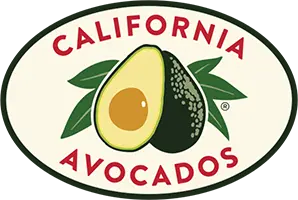
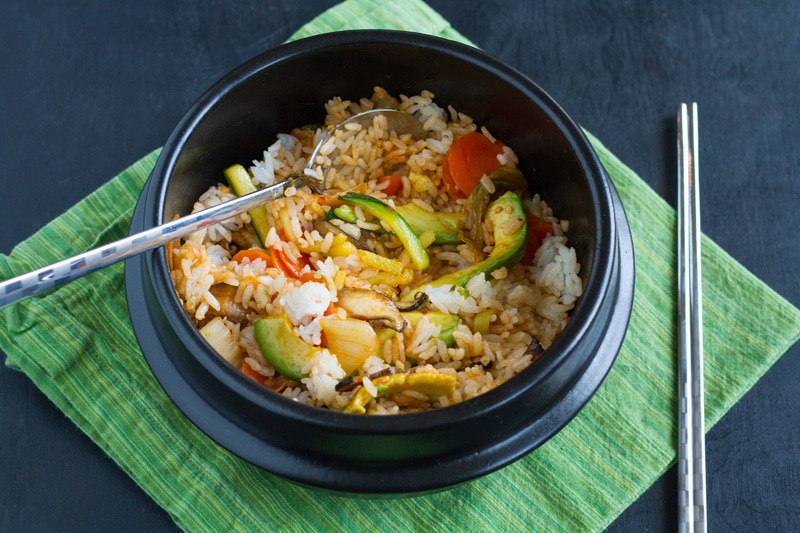
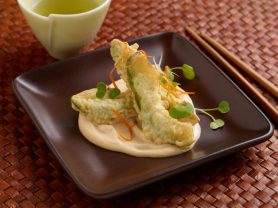
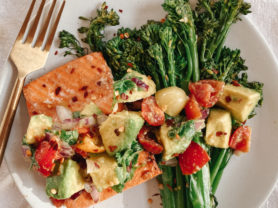
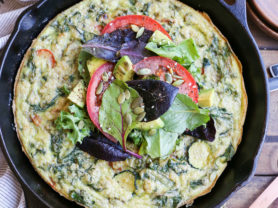
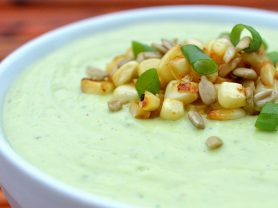
Comments